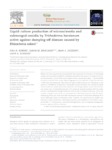Please use this identifier to cite or link to this item:
http://www.alice.cnptia.embrapa.br/alice/handle/doc/1011851| Title: | Liquid culture production of microsclerotia and submerged conidia by Trichoderma harzianum active against damping-off disease caused by Rhizoctonia solani. |
| Authors: | KOBORI, N. N.  MASCARIN, G. M.   JACKSON, M. A.   SCHISLER, D. A.   |
| Affiliation: | NILCE N. KOBORI, USDA; GABRIEL MOURA MASCARIN, CNPAF; MARK A. JACKSON, USDA; DAVID A. SCHISLER, USDA. |
| Date Issued: | 2015 |
| Citation: | Fungal Biology, v. 119, n. 4, p. 179-190, Apr. 2015. |
| Description: | Media and culturing protocols were identified that supported the formation of submerged conidia and microsclerotia (MS) by Trichoderma harzianum Rifai strain T-22 using liquid culture fermentation. Liquid media with a higher carbon concentration (36 g L -1) promoted MS formation at all C:N ratios tested. Hyphae aggregated to form MS after 2 d growth and after 7 d MS were fully melanized. This is the first report of MS formation by T. harzianum or any species of Trichoderma. Furthermore, submerged conidia formation was induced by liquid culture media, but yields, desiccation tolerance, and storage stability varied with C:N ratio and carbon rate. Air-dried MS granules (<4 % moisture) retained excellent shelf life under cool and unrefrigerated storage conditions with no loss in conidial production. A low-cost complex nitrogen source based on cottonseed flour effectively supported high MS yields. Amending potting mix with dried MS formulations reduced or eliminated damping-off of melon seedlings caused by Rhizoctonia solani. Together, the results provide insights into the liquid culture production, stabilization process, and bioefficacy of the hitherto unreported MS of T. harzianum as a potential biofungicide for use in integrated management programs against soilborne diseases. |
| Thesagro: | Rhizoctonia solani Trichoderma harzianum |
| NAL Thesaurus: | Biopesticides Soil-borne diseases Sclerotia Carbon nitrogen ratio |
| ISSN: | 1878-6146 |
| DOI: | 10.1016/j.funbio.2014.12.005 |
| Type of Material: | Artigo de periódico |
| Access: | openAccess |
| Appears in Collections: | Artigo em periódico indexado (CNPAF)  |










